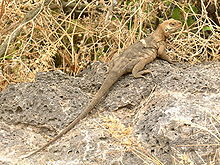Santa Fe Druse Head
| Santa Fe Druse Head | ||||||||||||
|---|---|---|---|---|---|---|---|---|---|---|---|---|

Santa Fe's glandular head ( Conolophus pallidus ) |
||||||||||||
| Systematics | ||||||||||||
|
||||||||||||
| Scientific name | ||||||||||||
| Conolophus pallidus | ||||||||||||
| Heller , 1903 |
The Santa Fe glandular head ( Conolophus pallidus ), also known as the Barrington glandular head or Santa Fe land iguana , is a type of glandular head . The animals are endemic to the Galapagos island of Santa Fe , the other Galapagos islands are home to the common druse head ( Conolophus subcristatus ). The species addition pallidus , from the Latin “pallidus” = pale, yellowish, refers to the lighter color of the animals compared to other land iguanas.
features
Males reach a body length of up to 114 cm and an average weight of 7.1 kg, females a body length of up to 100 cm and a weight of 4.3 kg on average. According to Heller, the head of the type specimen was short and broadest between the ear openings and the corners of the mouth, the profile of the muzzle convex . The ear openings are oval, slightly larger than the eyes and surrounded by small scales, the round nostrils are large. The top of the head is covered with convex, keeled scales. The dorsal body scales are small, conical and pointed. A dorsal scale ridge of enlarged scales extends from the neck to the tail, the highest of which is formed by nine tall conical scales on the neck. The underside is covered with larger, almost square, smooth scales. The tail is rounded and gradually tapers. It is covered with large, square, sloping scales. There are 22 to 23 femoral pores , in other animals these vary from 20 to 24. Heller described the color of the type specimen as clay-yellow on top with a large light brown spot between the hind limbs and another spot across the middle of the back. The legs become more brownish towards the toes. The underside is cream-colored, armpits and groin are pale pink. The whole neck and eyelids are bluish, the lip area and the sides of the head are mottled gray and yellow.
Habitat and way of life
Santa Fe Druse Heads are diurnal and inhabit dry grasslands and deciduous forests. They have a vegetable diet, 56% from cacti , but also from 25 other native and introduced plant species such as z. B. grasses, small trees, shrubs and herbs. During the breeding season, adult males defend an area of up to 20 m² and, if successful, mate with up to seven females. Between October and November, the females dig holes in sandy soil and lay 2 to 20 eggs in them. It takes up to four months for them to hatch.
Individual evidence
- ↑ a b Keith Christian, C. Richard Tracy, Warren P. Porter: Seasonal Shifts in Body Temperature and Use of Microhabitats by Galapagos Land Iguanas (Conolophus Pallidus). ( Online )
- ^ Conolophus pallidus in The Reptile Database
- ↑ a b c A. Arteaga, JM Guayasamin: Conolophus pallidus. 2019, in: A. Arteaga, L. Bustamante; JM Guayasamin (Eds): Reptiles of Ecuador. ( Online )
- ^ E. Heller: Papers from the Hopkins Stanford Galapagos Expedition, 1898-1899. XIV. Reptiles. 1903 in Proceedings of the Washington Academy of Sciences , Vol. 5, pp. 87, 88. ( Online )
Web links
- Conolophus pallidus in the endangered Red List species the IUCN 2013. Posted by: World Conservation Monitoring Center, 1996. Accessed October 14, 2013.
- Conolophus pallidus in The Reptile Database
- Das-Tierlexikon.de

